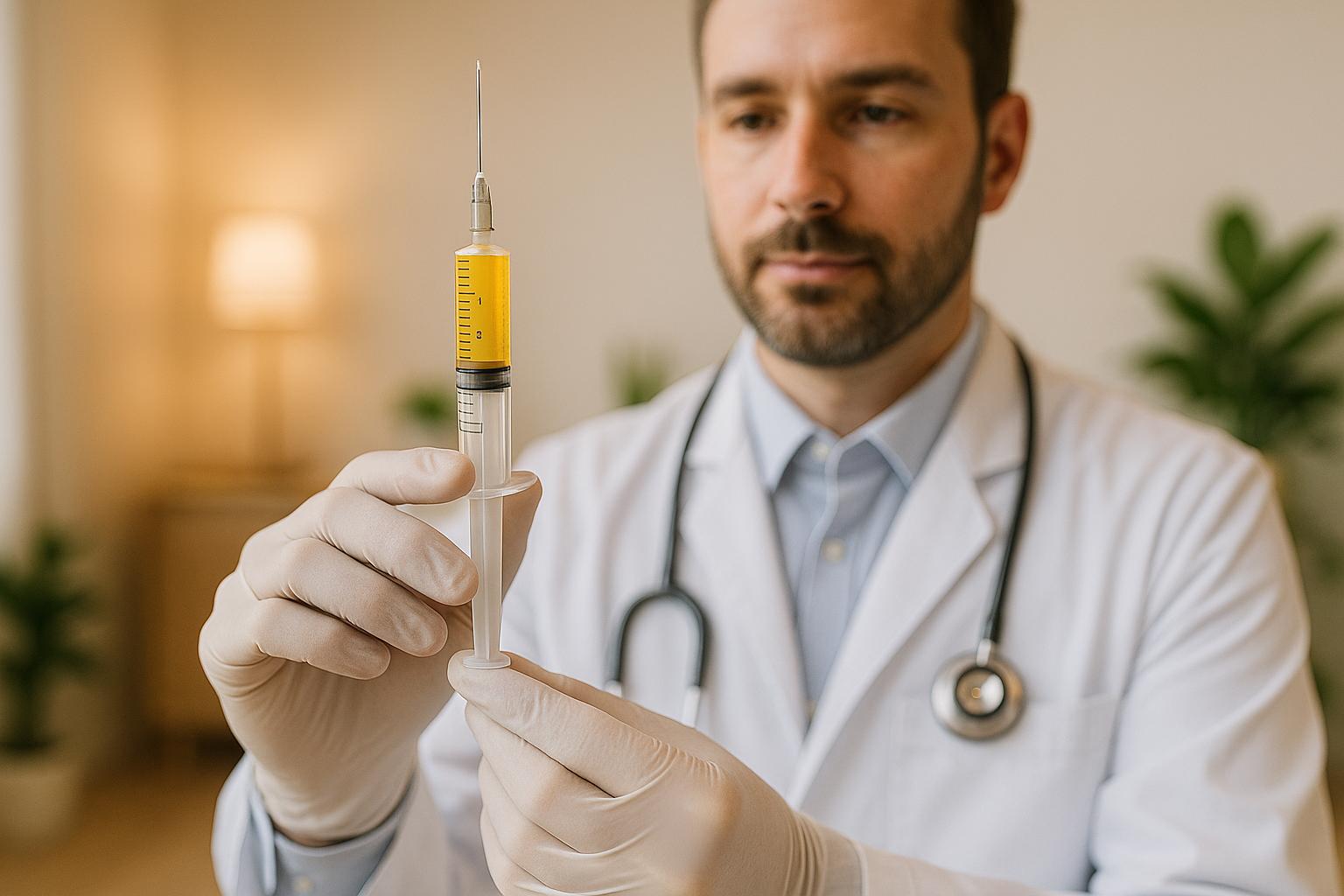Regenerative medicine offers solutions for pain by targeting the root causes rather than masking symptoms. Using your body’s natural healing mechanisms, treatments like stem cell therapy, PRP injections, and prolotherapy focus on repairing damaged tissues and reducing inflammation. These methods are minimally invasive, with shorter recovery times compared to surgeries, and are becoming popular alternatives for managing chronic pain.
Key Takeaways:
- Stem Cell Therapy: Uses multipotent cells to regenerate damaged tissues. Effective for arthritis, nerve injuries, and degenerative conditions. Costs start around $3,600.
- PRP Injections: Concentrated platelets from your blood promote healing and reduce inflammation. Common for osteoarthritis and tendon injuries. Relief can last up to a year.
- Prolotherapy: Injects a dextrose solution to stimulate tissue repair. Affordable (around $345) and suitable for chronic musculoskeletal pain.
Quick Comparison:
| Treatment | Cost | Best For | Recovery Time | Key Risks |
|---|---|---|---|---|
| Stem Cell Therapy | $3,600+ | Severe conditions (e.g., arthritis, nerve damage) | 2–12 weeks | Potential inflammation, high cost |
| PRP Injections | $500–$1,500 | Mild-to-moderate joint/tendon issues | 4–10 weeks | Injection site pain, infection |
| Prolotherapy | $345+ | Chronic musculoskeletal pain | Immediate | Temporary swelling, mild pain |
Each treatment has unique benefits and risks, making it essential to consult a specialist to determine the best option for your condition, budget, and goals.
Regenerative Medicine for Highly Effective Arthritis Treatment and Injury Repair
1. Stem Cell Therapy
Stem cell therapy taps into the body’s own repair systems by using multipotent cells. These cells naturally migrate to areas of damage, assisting in tissue repair and regeneration. Typically, stem cells are collected from the patient’s bone marrow or fat tissue, processed, and then injected directly into the site of injury or pain.
Mechanism of Action
After being introduced into the affected area, stem cells transform into the needed cell types and release growth factors that help reduce inflammation and encourage healing. For instance, in cases of arthritis, injecting stem cells into the joint can lead to the formation of new cartilage cells, helping to repair the damaged joint surface. This ability to regenerate tissue explains why stem cell therapy is being explored for a variety of pain-related conditions.
Conditions Treated
Stem cell therapy holds potential for treating numerous conditions linked to pain. For osteoarthritis, it may regenerate damaged cartilage, while in degenerative disc disease, it could restore spinal disc function. In neuropathic pain, stem cells show promise in repairing nerve tissue. A notable study by Pascual-Garrido et al. tracked patients with chronic patellar tendinopathy over five years, revealing significant pain reduction and improved clinical scores, with the most noticeable benefits appearing within the first two years and persisting through the study’s duration. Early research also suggests it could help with fibromyalgia and spinal cord injuries by reducing inflammation and reestablishing nerve communication.
Procedure Invasiveness
One of the key advantages of stem cell therapy is that it’s minimally invasive. The procedure typically takes 2–3 hours and avoids the need for major surgical incisions. Stem cells are harvested via a small bone marrow extraction or minor liposuction procedure, both performed under local anesthesia. The processed cells are then injected into the target area, often with imaging guidance to ensure accuracy.
Recovery Time
Recovery is generally quicker compared to traditional surgical options. Most patients can return to their daily routines within a few days. Pain relief often begins within 2–12 weeks, with more noticeable improvements taking place over 6–12 months. Some patients may experience mild tenderness or fluid drainage, but these effects usually resolve quickly. To protect the treated area, doctors often recommend avoiding high-impact activities for about a month, though this may vary depending on the condition being treated.
Evidence Strength
Research into stem cell therapy for pain management shows encouraging, though varied, results. For example, a 2022 review found that stem cell injections for lower back pain had a 40.7% success rate after six months, with 30% of participants reporting improved function. The strongest results so far are for conditions like osteoarthritis and tendon injuries, where multiple studies have documented reduced pain and improved tissue regeneration. Ongoing research continues to refine treatment methods and identify which patients are most likely to benefit, aiming to improve outcomes even further.
2. Platelet-Rich Plasma (PRP) Injections
Platelet-Rich Plasma (PRP) injections use your own blood to help alleviate pain and reduce inflammation. The process is straightforward: a small sample of your blood is taken, spun in a centrifuge to concentrate the platelets, and then injected directly into the affected area. This concentrated plasma contains five to ten times the platelets found in regular blood, creating a powerful environment for healing.
Mechanism of Action
The magic of PRP lies in its ability to deliver growth factors directly to injured tissue. When platelets are activated, they release these growth factors, which kickstart the repair process. Dr. Barbaro J. Perez, an orthopedic surgeon at Riverside Orthopedic and Sports Medicine Specialists Gloucester, explains:
"PRP treatment uses your own blood to help reduce pain, improve joint function and possibly slow, stop or even repair your cartilage damage."
By boosting the concentration of these natural healing agents, PRP injections speed up tissue repair and recovery.
Conditions Treated
PRP injections are used to address a variety of conditions, including osteoarthritis, sprains, tendon injuries, joint pain, and other musculoskeletal issues. Osteoarthritis, which impacts millions globally, is one area where PRP has shown particular promise. Dr. Sarah Kennedy, a sports medicine expert at Sideline Orthopedics and Sports, highlights its benefits:
"Platelet-rich plasma therapy uses the body’s natural defenses to decrease inflammation and pain while restoring function."
This treatment taps into the body’s own healing mechanisms to provide relief and improve mobility.
Procedure Invasiveness
PRP injections are minimally invasive. The process involves only a simple blood draw followed by an injection into the problem area. Most patients describe the discomfort as similar to that of a routine injection. To ease any potential pain, local anesthesia can be applied during the procedure.
Recovery Time
Recovery after PRP treatment is relatively quick. Most patients can return to their regular activities within 24 hours. However, it’s recommended to rest on the day of the procedure and avoid overusing the treated area for the next two days. Staying hydrated and following basic recovery instructions can optimize healing.
Pain relief typically begins 4 to 6 weeks after the injection, with full recovery taking anywhere from 4 to 10 weeks. In some cases, the healing process may extend to 3–6 months. Physical therapy often starts two weeks after the injection, with more intensive exercises introduced around the 4-week mark . Strenuous activities should be avoided for at least six weeks to ensure proper recovery.
Evidence Strength
Research supports the effectiveness of PRP injections, especially for managing osteoarthritis pain and improving joint function. Studies suggest that PRP not only eases pain but may also slow the progression of cartilage damage. The effects of treatment can last 1 to 2 years, making it a cost-effective option for those dealing with chronic pain. As research evolves, experts continue to refine PRP techniques and identify the patients most likely to benefit from this therapy.
sbb-itb-d9e542d
3. Prolotherapy
Prolotherapy is a straightforward and budget-friendly option in the realm of regenerative medicine for pain relief. It taps into the body’s natural healing abilities by injecting an irritant solution, commonly a dextrose (sugar water) mix, into damaged tissues.
How It Works
The treatment relies on a 10–30% dextrose solution to create controlled inflammation. This process releases cytokines and growth factors, which attract immune cells like macrophages and neutrophils. These cells kickstart tissue repair, encouraging new collagen growth and improving the strength and stability of joints and tissues.
One of prolotherapy’s key features is that it doesn’t require stem cells to work. By stimulating the body’s own repair mechanisms, it helps restore joint and tissue function without relying on additional cell-based therapies. There’s also evidence suggesting the injections might influence how pain signals are processed, adding another layer to its effectiveness in managing chronic musculoskeletal conditions.
What It Treats
Prolotherapy often serves as a backup option when standard treatments fail to relieve chronic musculoskeletal pain. Research supports its use for conditions like low back pain, tendinopathies, and osteoarthritis.
The numbers speak for themselves. For instance, in a study with 37 people suffering from chronic tailbone pain, 25% dextrose injections over two months brought average pain scores down from 8.5 to 2.5 on a 10-point scale. Out of these, 30 participants reported significant relief. Another study on tennis elbow showed pain scores dropping from 5.1 at the start to just 0.5 after 16 weeks, with benefits lasting a year. In yet another example, 24 male athletes with chronic groin pain saw remarkable recovery – 20 became completely pain-free, and 22 returned to unrestricted sports. These results, combined with minimal invasiveness and quick recovery, make prolotherapy a strong contender for pain management.
Procedure and Recovery
Prolotherapy is one of the least invasive treatments in regenerative medicine. It’s typically done during a routine office visit and often doesn’t require anesthesia. Multiple dextrose injections are administered, and patients can usually return to their normal activities right away.
Some minor side effects, such as pain, swelling, or bruising, might occur temporarily, but these are part of the body’s natural healing response.
Evidence and Effectiveness
Research on prolotherapy covers a range of conditions, with varying levels of evidence:
| Condition | Evidence Rating | Key Findings |
|---|---|---|
| Lateral epicondylosis (tennis elbow) | A | Strong positive results from small randomized controlled trials |
| Non-specific low back pain | B | Shows promise, though some studies report mixed outcomes |
| Knee osteoarthritis | B | Moderately strong evidence supporting its effectiveness |
| Achilles tendinopathy | B | Pain reduced by 88% at rest and 84% during regular activities |
| Plantar fasciitis | B | 16 out of 20 participants reported good or excellent treatment outcomes |
Another major advantage of prolotherapy is its affordability. It costs less than stem cell or PRP therapies, making it more accessible to a wider range of patients. Long-term benefits are also well-documented. For example, in a study on Achilles tendinopathy, patients maintained significant pain reductions (88% during rest, 84% during regular activities, and 78% during sports) even after a year. Ultrasound results confirmed a noticeable decrease in tendon thickness, further validating its effectiveness.
Benefits and Drawbacks
Every treatment comes with its own set of advantages and risks, and understanding these differences is crucial for selecting the right approach to manage your pain.
Stem cell therapy stands out for its ability to replace damaged tissue through differentiation. It has shown promise in treating a variety of pain conditions, such as neuropathic pain, discogenic back pain, osteoarthritis, and other musculoskeletal issues. However, it also carries the highest risk, with potential concerns like tumor formation, inflammation, and disease development. On top of that, it’s typically the most expensive option and requires thorough screening to rule out conditions like bone marrow cancers or immune deficiencies.
Here’s a quick look at the benefits and drawbacks of each treatment:
| Treatment | Key Benefits | Main Drawbacks | Best For |
|---|---|---|---|
| Stem Cell Therapy | Replaces damaged tissue; effective for many pain types | High risk of tumors and inflammation; very costly | Severe conditions when other treatments fail |
| PRP Injections | Up to 1-year symptom relief; may slow osteoarthritis progression | Risk of injection site pain and infection | Mild-to-moderate osteoarthritis; chronic ligament/tendon injuries |
| Prolotherapy | Affordable; reduces inflammation effectively | Limited to specific conditions; may need multiple sessions | Chronic musculoskeletal pain; when other options fail |
PRP injections are a reliable and relatively safe option. They’re particularly effective for mild-to-moderate osteoarthritis and chronic ligament or tendon injuries. Research suggests that PRP can provide symptom relief for up to a year in cases like knee osteoarthritis. It may also slow the progression of osteoarthritis while reducing pain and encouraging tissue repair. The main risks are minor, such as injection site pain or infection. PRP is versatile, benefiting conditions like osteoarthritis, tendinopathies, spine disorders, and various injuries.
Prolotherapy offers a cost-effective alternative. It’s known for reducing inflammation and pain while promoting tissue regeneration. This treatment works well for conditions like osteoarthritis, degenerative joint issues, chronic pain, spine problems, and stubborn tendinopathies, including plantar fasciitis. Side effects are usually mild but can include sleep disturbances, nerve pain, irregular menstruation, or, in rare cases, lumbar puncture headaches.
Viscosupplementation is another option, FDA-approved specifically for knee osteoarthritis. It can provide pain relief and improved joint function for up to 26 weeks, especially when other conservative treatments haven’t worked. However, it’s limited to knee joints, and though rare, serious complications like hemarthrosis, septic arthritis, or allergic reactions can occur.
Each therapy has distinct benefits and risks, so the best choice depends on your condition, budget, and comfort with potential side effects. Chronic pain impacts 11% to 19% of adults, making these treatment options increasingly relevant. Unlike traditional pain management, which often focuses on symptom control, regenerative medicine takes a different approach by aiming to repair the underlying tissue damage.
Regardless of the treatment, all regenerative therapies share some common contraindications – active infections and blood clotting disorders are two key examples. Your healthcare provider will assess your overall health, immune status, and any allergies before recommending the most suitable option. These considerations are essential when discussing your treatment plan.
Conclusion
The reviews above highlight how regenerative therapies can serve as tailored solutions for managing various chronic pain conditions, offering hope to millions of Americans seeking alternatives to traditional treatments.
PRP injections have shown promise in addressing mild-to-moderate osteoarthritis and chronic ligament injuries, backed by extensive research. Prolotherapy, priced around $345, provides a cost-effective option, while stem cell therapy, starting at $3,600, represents a cutting-edge approach but comes with a higher price tag. Stem cell therapy is typically considered for more severe cases where other treatments have fallen short. Though it holds the potential to restore tissue function, its cost and the current stage of research make a thorough discussion with your healthcare provider essential.
Prolotherapy works by encouraging the body’s natural healing process through controlled inflammation, making it effective for musculoskeletal conditions.
Dr. Scott A. Rodeo from the HSS Center for Regenerative Medicine explains:
"The mantra for precision medicine is ‘the right treatment for the right patient at the right time.’ If we can identify the best PRP or cell therapy formula for each individual treatment, we will have a much more precise way of offering this to patients".
When choosing a therapy, consider your specific pain condition, budget, and comfort with potential risks. For knee osteoarthritis or chronic ligament issues, PRP or viscosupplementation may be a good starting point. Prolotherapy is well-suited for chronic tendon pain, while more complex conditions might benefit from stem cell therapy.
A consultation with a regenerative medicine specialist can guide you toward the treatment that best matches your needs, lifestyle, and long-term goals for pain relief.
FAQs
How can I find the best regenerative medicine treatment for my pain?
If you’re looking for the right regenerative medicine treatment to address your pain, the first step is to consult a healthcare provider experienced in regenerative therapies. They’ll evaluate your condition – considering factors like the type, severity, and location of your pain – and may recommend options such as stem cell therapy, platelet-rich plasma (PRP), or prolotherapy. These treatments aim to repair damaged tissues and help alleviate pain.
Your doctor will also take into account your overall health and the specifics of your injury to see if regenerative therapy is a good fit for you. These treatments are especially helpful for issues like chronic joint pain, musculoskeletal injuries, and soft tissue damage. A tailored assessment is essential to pinpoint the therapy that best suits your situation.
What are the risks and side effects of regenerative treatments for pain?
When performed by qualified professionals, regenerative medicine treatments are generally safe. However, it’s important to understand the potential risks associated with each option:
- Stem Cell Therapy: While rare, risks can include infection, immune reactions, or complications from unapproved procedures. Severe side effects, though uncommon, are still possible.
- PRP Injections: These are usually low-risk but might cause temporary swelling, pain, or stiffness at the injection site. They’re not suitable for individuals with untreated infections or certain blood disorders.
- Prolotherapy: This treatment is generally safe, with minor side effects like soreness, swelling, or stiffness at the injection site. Serious complications are extremely rare.
Among these treatments, stem cell therapy tends to carry a slightly higher risk profile compared to PRP and prolotherapy. Always consult a trusted medical professional to determine the most suitable and safe option for your needs.
How effective are regenerative medicine treatments for managing chronic pain over time?
Regenerative medicine treatments like stem cell therapy and platelet-rich plasma (PRP) injections are gaining attention for their ability to address chronic pain at its source. Instead of just hiding the symptoms, these therapies focus on repairing tissue damage and reducing inflammation, which are often the underlying causes of pain.
Though research is still evolving, early studies indicate that these treatments may help lower reliance on pain medications and enhance overall quality of life. Many patients have reported long-lasting relief, especially for issues like joint pain, injuries, and persistent discomfort. That said, results can differ from person to person, so it’s crucial to consult with a qualified healthcare provider to figure out the best treatment plan for your situation.



